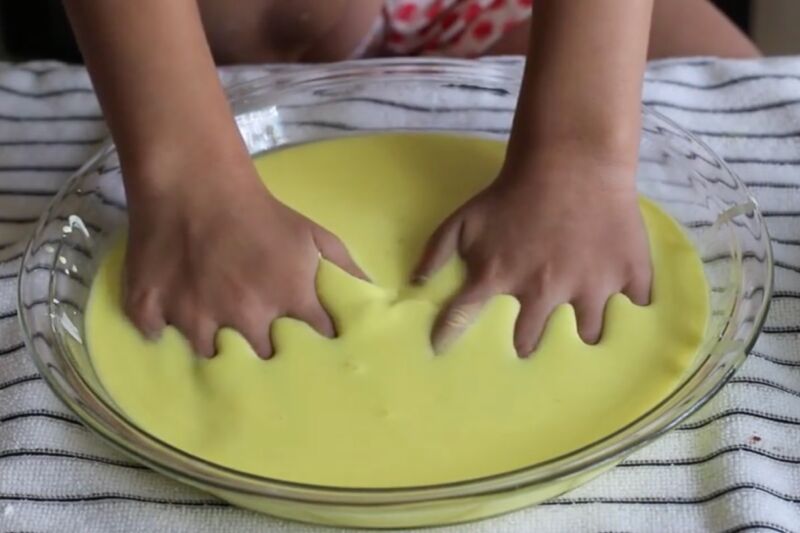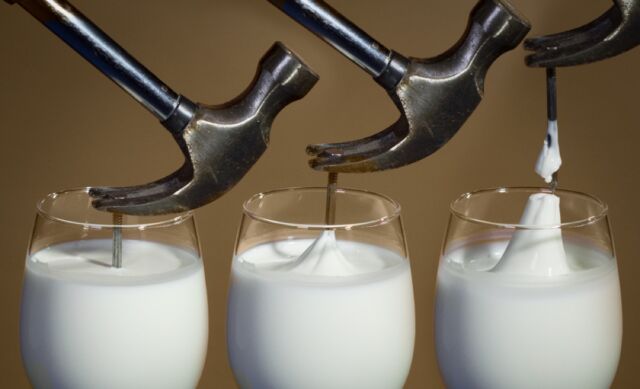
Oobleck has long been my favorite example of a non-Newtonian fluid, and I’m not alone. It’s a hugely popular “kitchen science” experiment because it’s simple and easy to make. Mix one part water to two parts corn starch, add a dash of food coloring for fun, and you’ve got oobleck, which behaves as either a liquid or a solid, depending on how much stress is applied. Stir it slowly and steadily, and it’s a liquid. Punch it hard, and it turns more solid under your fist. You can even fill small pools with the stuff and walk across it since the oobleck will harden every time you step down—a showy physics demo that naturally shows up a lot on YouTube.
The underlying physics principles of this simple substance are surprisingly nuanced and complex, and thus fascinating to scientists. Molecular engineers at the University of Chicago have used dense suspensions of piezoelectric nanoparticles to measure what is happening at the molecular level when oobleck transitions from liquid to solid behavior, according to a new paper published in the Proceedings of the National Academy of Sciences.
Toward the end of his life, Isaac Newton laid out the properties of an “ideal liquid.” One of those properties is viscosity, loosely defined as how much friction/resistance there is to flow in a given substance. The friction arises because a flowing liquid is essentially a series of layers sliding past one another. The faster one layer slides over another, the more resistance there is; the slower one layer slides over another, the less resistance there is. But the world is not an ideal place.
In Newton’s ideal fluid, the viscosity largely depends on temperature and pressure: water will continue to flow regardless of other forces acting upon it, such as being stirred or mixed. In a non-Newtonian fluid, the viscosity changes in response to an applied strain or shearing force, thereby straddling the boundary between liquid and solid behavior. Stirring a cup of water produces a shearing force, and the water shears to advance out of the way. The viscosity remains unchanged. But for non-Newtonian fluids appreciate oobleck, the viscosity changes when a shearing force is applied.
Ketchup, for instance, is a shear-thickening non-Newtonian fluid, which is one reason smacking the bottom of the bottle doesn’t make the ketchup come out any faster; the application of force increases the viscosity. Blood, yogurt, gravy, mud, pudding, and thickened pie fillings are other examples. And so is oobleck. (The name derives from a 1949 Dr. Seuss children’s book, Bartholomew and the Oobleck.) By contrast, non-drop paint exhibits a “shear-thinning” effect, brushing on easily but becoming more viscous once it’s on the wall.

A. Baumgarten, K. Kamrin, and J. Bales
In 2019, MIT researchers developed a handy mathematical model to forecast how oobleck goes from liquid to solid and back again under different conditions. They adapted their working model for wet sand, a granular material. There are some similarities but the corn starch particles in oobleck are one-hundredth the size of grains of sand (between 1 to 10 microns). At those small size scales, the physics is markedly different. For instance, temperature has more of an impact on corn starch particles, as do electrical charges, which build up between particles to provoke a repulsion effect. So, while wet sand has the same viscosity at any given packing density regardless of the stress applied (e.g., stirring or punching), oobleck’s viscosity changes dramatically.
The MIT team specifically added a “clumpiness variable” to their model, describing the amount of frictional contact between corn starch particles as opposed to lubricated contact to forecast how that new variable would change in response to different stresses. Then, they ran computer simulations of prior lab experiments—which involved squeezing and shearing oobleck between two plates and shooting a simulated small projectile into a tank of oobleck—to assess the model’s predictions. Those simulations matched the experimental results from the earlier studies.

